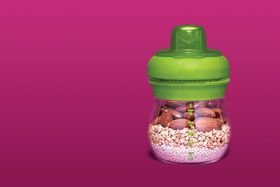Baby Nutrition: Everything You Need to Know
Discover everything you need to know about baby nutrition, including how much fat a baby needs per day and essential nutrition for infants. Get expert advice and tips on providing the best nutrition for your little one.
Updated May 23, 2024

While in the womb, your baby enjoyed receiving an endless supply of optimal nutrition from you. However, welcoming your baby into the world now means that you have a responsibility for feeding your baby in a very different way. More growth occurs in your baby’s first year than at any other time in life. Consequently, optimal nutrition is a key factor in the normal growth and development of your baby. It can be difficult and confusing to sift through the endless amounts of information on nutrition for the baby that you may be bombarded with. From the internet to well-intentioned friends and family, there seems to be a constant buzz about what to feed your baby and when. Infant nutrition doesn’t have to be complicated or stressful. Optimal nutrition for your baby is imperative; here’s our guide to help you through every step of the journey.
» Make sure your baby is getting all needed nutrients with this plant-based cereal
How does nutrition affect a baby’s growth and development?
Because of the rapid acceleration of growth during your baby’s first year, it’s no wonder that nutrition has a significant impact on your baby’s development, and even long-term health status. Moreover, nutrition plays a pivotal role in the formation of your baby’s brain which will lay the foundation for the development of cognitive, motor, and social-emotional skills throughout childhood and beyond. To ensure proper growth and development, a baby should get an adequate amount of essential nutrients by eating the right quantities of various types of foods. Because infancy is a period of accelerated growth, nutrient requirements per pound of body weight are correspondingly higher than at any other time in your baby’s life.
» Discover the best nutrition drinks for kids' balanced growth and development
Baby Nutrition Guidelines
All of the following information is based on the Dietary Reference Intakes developed by the Food and Nutrition Board to help determine adequacy of diets.
Carbohydrates (Adequate Intake)
Babies 0-6 months: 60 grams of carbohydrate each day Babies 7-12 months: 95 grams of carbohydrate each day
Functions
Carbohydrates supply your baby with energy needed for the growth of brain tissue, muscles, and other organs, and helps supply the energy needed for movement and other functions. Additionally, adequate carbohydrate intake allows for the protein in your baby’s diet to be used for building new tissue.
» Learn more about the importance of carbohydrates to your baby and toddler
Sources
During the first six months of life, your baby will receive the carbohydrates needed from breast milk or infant formula. Lactose is the major type of carbohydrate consumed by babies as it is the leading carbohydrate source found in breast milk and most milk-based baby formulas. Some babies may struggle with digesting lactose, or galactose (a part of lactose) and may require a lactose-free formula. These formulas may provide carbohydrates in the form of sucrose, corn syrup, or corn syrup solids. Other formulas may contain differing carbohydrate sources in the form of modified corn starch, tapioca dextrin, or tapioca starch. As babies begin eating solid foods, they will begin to consume carbohydrates from an assortment of sources including various grains, fruits, and vegetables.
» Discover the best lactose-free formula made from tapioca
Protein (Adequate Intake)
Babies 0-6 months: 9.1 grams of protein each day Babies 7-12 months: 11 grams of protein each day
Functions
Protein is an essential component of your baby’s diet for building, maintaining, and repairing new tissues. Furthermore, protein is needed to manufacture essential enzymes, hormones, and antibodies.
» Learn more about infant and toddler protein needs
Sources
During the first six months, your baby will meet her/his protein needs from breast milk and/or infant formula. At around six months of age, solid foods will likely become a more important part of your baby’s diet which will add to the amount of protein they consume. Protein sources during this stage may include meat, fish, poultry, eggs, cheese, yogurt, beans, legumes, and various grain products.
» Try this easy high-in-protein peanut butter balls recipe
Fats (Adequate Intake)
Babies 0-6 months: 31 grams of fat each day. Babies 7-12 months: 30 grams of fat each day. Essential fatty acids are a type of fat that must be provided in the diet to maintain health. Linoleic acid (LA) and α-linolenic acid (ALA) are both essential fatty acids. Two other fatty acids, arachidonic acid (ARA) and docosahexaenoic acid (DHA), are derived from linoleic acid and α-linolenic acid respectively. They are also considered essential fatty acids but only when linoleic acid (LA) and α-linolenic acid (ALA) are lacking in the diet.
» Ensure your little one is getting daily fat dose with this formula
Functions
Fat is a major source of energy for babies as it supplies almost 50% of the calories consumed in breast milk and infant formula. Adequate fat intake allows for the accumulation of stored fat in the body. This fat storage provides insulation to reduce heat loss and also serves as padding to protect vital organs. Fat intake also allows for the absorption of fat-soluble vitamins including vitamins A, D, E, and K. The essential fatty acids are required for normal brain development, healthy eye functioning, and immune system support.
» Learn more about rich-in-fat foods that will help your toddler gain weight
Sources
Both breast milk and infant formula will provide adequate fat including essential fatty acids. While the lipid content of breast milk can vary, after about the first 2 weeks of breastfeeding, breast milk provides approximately 50% of its calories from lipids. Infant formulas will also provide approximately 50% of their calories as fat.
» Learn more about how to include healthy fats in your child's diet
Nutrients to Consider Supplementing
Vitamin D
Adequate Intake (AI) for Infants 0–12 months 5 µg (200 IU) per day
Functions
Adequate vitamin D intake is required for the proper formation of bones and for the ability to absorb calcium and phosphorus in the body. Vitamin D deficiency can lead to inadequate absorption of calcium and phosphorus resulting in insufficient bone formation and tooth mineralization.
» Learn more about essential nutrients for kids
Supplementation
The American Academy of Pediatrics recommends all full or partially breastfed and formula fed infants who drink less than 32 ounces of formula per day, be supplemented with 400 IU of vitamin D. Speak with your doctor about the ideal dosage for your baby.
Iron
Adequate Intake (AI) for Infants 0 - 6 months 0.27 mg per day RDA for Infants 7 - 12 months 11 mg per day
Functions
Iron is a mineral essential to proper growth and the formation of healthy blood cells. Adequate iron intake also aids in the prevention of iron-deficiency anemia.
» Read more about how to recognize iron deficiency in your baby
Supplementation
The majority of healthy, full-term infants are born with adequate iron stores that are not depleted until about 4 months of age. However, as babies approach 4 months, they may become depleted of these important iron stores and breast milk is low in iron. Therefore, the American Academy of Pediatrics recommends giving breastfed infants 1 mg per kg of body weight per day of a liquid iron supplement starting at four months until iron-containing solid foods are introduced at around six months of age. As your baby begins to eat more solid food, serving them iron-rich foods such as iron-fortified cereal, meat or beans at least twice per day, will help them meet their iron needs.
» Discover this baby cereal that meets your baby's daily iron needs
Nutrition for Babies in the First 6 Months
Many medical organizations, including the American Academy of Pediatrics (AAP) and the American College of Obstetricians and Gynecologists (ACOG), recommend exclusive breastfeeding for the first 6 months of your baby’s life. It is important to note that exclusively breastfed babies won’t require any formula, juice, or water. As a general rule of thumb, most newborns eat every 2 to 3 hours, which is about 8 to 12 times every 24 hours. During those first few feedings, your baby may only take in a half ounce per feeding. After the first day or two, your baby will typically drink 1 to 2 ounces at each feeding. By two weeks, the amount will increase to about 2 to 3 ounces by two weeks of age.
» Read more about expert baby nutrition tips
A Guide for Breastfeeding Your Baby
First few weeks: nurse every 1-1/2 to 3 hours By month 1: nurse around 7–9 times per 24 hours By 2 months: nurse 5-7 times per 24 hours By 6 months: nurse 5 to 6 times per day
A Guide for Bottle Feeding Your Baby
First few weeks: 1 to 3 ounces of formula every three hours By month 1: At least 4 ounces of formula 6 to 8 times per 24 hours By 2 months: 5 to 6 ounces 5 to 6 times per 24 hours By 6 months: 6 to 7 ounces 5 to 6 times per day plus the introduction of solid foods.
Nutritional Composition of Breastmilk
Breast milk provides the perfect combination of carbohydrates, proteins, fats, vitamins and minerals to ensure your baby’s healthy growth and development. Breast milk also contains digestive enzymes, hormones, and growth factors which will protect your baby from infections and disease.
» Learn more about formula supplementing while breastfeeding
The Three Phases of Breast milk
In the first few weeks after a baby is born, breast milk will progress through three main stages: colostrum, transitional breast milk, and mature breast milk.
- Colostrum (produced days 1-7) Colostrum is the first breast milk your body produces This thick, yellow and sticky substance is often referred to as “liquid gold” because of its nutritionally dense properties and its high immune-protective composition. Colostrum contains high concentrations of antibodies and white blood cells which provide a boost of immunity for babies. Colostrum also coats and seals your baby’s delicate GI system making it an ideal first food.
- Transitional breast milk (produced days 8 – 20) Transitional milk is a combination of colostrum and mature milk. As the change between colostrum and mature milk takes place, transitional milk becomes higher in fat, calories and lactose, making it the ideal food during this rapid time of growth. Much like colostrum, this unique milk is also chock-full of protective antibodies and helpful bacteria to keep your newborn protected.
- Mature breast milk (produced from 20 days after birth, onwards) By the time your baby is 2-3 weeks old, your milk changes over to mature milk. The nutritional content and levels of ingredients in mature milk generally remain fairly consistent. However, the composition of your breast milk can still change from day to day and feed to feed to meet your baby’s unique nutritional needs.
Besides providing ideal infant nutrition there are a myriad of benefits to breastfeeding.
» Read more about when to start formula while breastfeeding
Breast Milk Contains Antibodies
The antibodies in breast milk are particularly high in colostrum, however, breast milk will provide antibodies for your baby throughout all stages of breastfeeding. The antibodies in breastmilk can provide a much-needed immunity boost that protects your baby from a variety of conditions and illnesses. Research has shown that exclusive breastfeeding for the first 6 months of life can reduce the risk of respiratory tract infections. Additionally, a 2015 review, found that exclusive breastfeeding reduced the risk of middle ear infections by 43%. Breast milk also contains antibodies that are protective for your baby’s GI system.
A recent study found that breastfeeding was associated with a 50% decrease in diarrhea episodes and also found a 72% decrease in hospital admissions related to diarrhea.
» Read more about how to support your baby's immunity with nutrition
Breastfeeding Promotes Healthy Weight Gain
Breastfed infants are more likely to gain the ideal amount of weight as they grow while breastfeeding also appears to help in preventing childhood obesity down the road. This meta-analysis showed that the risk of childhood obesity was lower in breastfed children by 22% compared with those who were never breastfed. Research has also found that children who received breastmilk for at least 12 months, were more likely to have lower fat stores at 4 years old versus non-breastfed children.
According to another study, breastfed infants have lower risk of obesity, hypercholesterolemia, high blood pressure, cardiovascular diseases and type 2 diabetes in adulthood.
Breastfeeding May Promote Intelligence
Breastfeeding has been linked to higher IQ scores in later childhood. One study found that breastfeeding was associated with improved performance on intelligence tests 30 years later, which may have an important effect for adults by increasing educational status and increasing income in adulthood.
» Learn more about the importance of breastfeeding in a baby's brain development
Benefits of Breastfeeding for You
Can Promote Positive Feelings
Two hormones, prolactin and oxytocin are produced during breastfeeding and can enhance the positive feeling associated between the bond you have with your baby. Prolactin can produce a calm, nurturing sensation that promotes relaxation during this bonding time. While oxytocin can foster a strong sense of love and attachment between you and your baby. Oxytocin also helps your uterus return to its pre-pregnancy size and may reduce uterine bleeding after birth.
Reduces the Risk of Certain Cancers
Research shows that women who have breastfed have reduced rates of breast and ovarian cancer later in life. In this large epidemiological study, researchers found that for every 12 months a woman breastfed, her risk of breast cancer decreased by 4.3%. Furthermore, recent research has found that breastfeeding is associated with a significant decrease in risk of ovarian cancer overall and particularly for the most lethal type of ovarian cancer.
Helps with Weight Management
After giving birth, you may feel eager to return to your pre-pregnancy shape and weight. To fuel your milk production, breastfeeding burns around 500-700 extra calories per day. On average, exclusively breastfeeding mothers may see a loss of 1 to 2 pounds a month and over time, and studies have shown that breastfeeding moms tend to lose more weight than mothers who do not breastfeed.
How Often Should You Breastfeed Your Baby?
Ideally, breastfeeding should be initiated within the first hour after birth whenever possible. Research has shown that the timing of that initial feeding may impact your supply of breastmilk. In the first few days after birth, milk production is primarily a supply and demand operation, therefore, the more milk your baby takes from you, the more milk your body produces. It is important to aim to breastfeed 8-12 times in 24 hours (both day and night) for the first month. This will help to stimulate milk production and help your baby regain weight that may be lost after birth. In those first few weeks of life, breastfeeding should be "on demand", meaning when your baby is hungry. This will likely be about every 1-1/2 to 3 hours. As your baby gets older, s/he will nurse less often, and may even have a more predictable schedule. By the time your baby is 1–2 months old, they will probably want to nurse around 7-9 times per day. From 2 to 5 months old, your baby’s feeding may decrease to 5 to 6 times per day.
» Learn more about how much formula you should give to your baby
Formula Feeding Your Baby
Although health experts agree that human milk is the best nutritional choice for babies, breastfeeding may not be possible for all women. There are many factors that play a role in the decision on whether to breast or bottle feed. These decisions may be based on comfort level, lifestyle, and specific medical situations. For people who can't breastfeed or for those who choose not to, infant formula is designed to meet the nutritional needs of babies and is considered a healthy alternative to breastmilk.
» Check this guide for more information about formula feeding
Nutritional Composition of Baby Formula
Because of the Infant Formula Act, the Food and Drug Administration regulates all infant formula production and ensures that all infant formula meets the nutritional standards babies need. Infant formulas mimic the nutritional profile of breastmilk to promote the normal growth and development of your baby. There are three major types of infant formulas: cow-milk-based formula, soy-based formula, and specialized formula. Consider getting expert advice to find the perfect fit for your little one, thereby eliminating the need for changing formulas every couple of weeks — and dealing with a fussy babe in between.
» Read more about hypoallergenic formula ingredients
Infant Formula Types
Cow’s milk-based formula
Cow’s milk provides the basis for most infant formulas. These formulas contain added vegetable oils, vitamins, minerals and iron that meet all of the nutritional needs for most healthy, full term infants.
Soy protein formula
Formulas made from soy proteins are effective options for infants with galactosemia (when a baby is unable to process a simple sugar called galactose) or if a baby has a lactase deficiency (unable to tolerate lactose). Although sometimes effective in reducing colic and helping meet the nutritional needs of a baby with a milk allergy, some infants who are allergic to cow’s milk may also be allergic to soy.
Specialized formulas
Specialized formulas are meant for babies who are unable to tolerate cow’s milk or soy based formulas. They contain protein that has been hydrolyzed, or broken down into smaller sizes than those found in cow or soy-based products. For infants who have a protein allergy, these hydrolyzed formulas may be a suitable alternative. Else is working to develop an alternative to these three formulas as it uses almonds, tapioca, and buckwheat as a protein source. Stay tuned for details of when the plant-based, soy-free infant formula will be available.
Benefits of Formula Feeding
Despite the numerous health benefits of breastfeeding, formula feeding can provide flexibility for families, which breastfeeding may not provide. When bottle feeding, any parent or caregiver can feed the baby which allows a mother to share in the feeding duties. This scenario can provide flexibility for mothers and also helps caretakers (including mom) get much-needed rest. Bottle feeding can also help partners feel more involved in the feeding process which facilitates a distinctive bond between babies and various helpers.
» Take a look at benefits of organic baby formula
Responsive Formula Feeding
It can sometimes be a mystery as to how to meet the ever-changing needs of your baby. The frequent and unpredictable nature of infant feeding can be a challenge and feel overwhelming. Despite their lack of verbal abilities, babies can communicate through different means. Your baby will send various signals or cues to help you to know if they are hungry or full. Responding to your baby’s cues in a warm, loving, and prompt manner is called responsive feeding. This reaction will not only help your baby to foster a secure attachment relationship with you, but it will set the stage for longer-term healthy eating habits and behaviors down the road.
» Read more about how to supplement with formula at night
Signs Your Baby is Hungry
- Turns their head toward anything that touches his face and opens their mouth. This is known as rooting.
- Makes sucking noises or motions
- Clenches their fingers or fists over their chest and tummy
- Flexes their arms and legs
- Moves their hands to their mouth or put things in their mouth
Signs Your Baby Is Full
- They start and stop feeding often
- Unlatches often while breastfeeding
- They spit out or ignore the bottle or breast
- They turn away from the breast or bottle
- Slow down or fall asleep and your breasts feel less full
- They continuously fidget or get distracted easily
- Close their mouth or turn their head away when offered the breast
Nutrition for Babies 6 to 12 Months
Breastmilk and/or formula is still a very important component of your baby’s diet beyond the first 6 months. Once solid food is introduced, breastmilk and/or formula will continue to provide important nutrition for the baby. This is why experts recommend continuing to breastfeed or provide formula through the introduction of solid foods.
» Take a look nutritious food choices for your 8-month-old
How Much Should You Feed Your Baby?
- Around age 6 months, your baby should be taking in around 32 ounces of breastmilk or formula plus 1 to 2 servings of cereal and/or fruit per day.
- Between the ages of 6 and 9 months, your baby should be taking in 24 to 32 ounces of breastmilk or formula. Additionally, they need 2 servings of cereal, 1 to 2 servings of fruit, 2 servings of vegetables, and 2 servings of meat per day.
- Between 9 and 12 months, your baby will still require 16 to 24 ounces of breastmilk or formula, 2 servings each of cereal, fruit, vegetables, and meat, and either ½ slice of bread or ¼ cup soft pasta every day.
» Discover when to start introducing finger foods to your baby
Introducing Your Baby to Solids
As your baby’s mouth, tongue, and digestive tract begin to mature, your baby will make the shift from having the ability to suck and swallow only breast milk or formula, to being able to chew and eat a wide variety of foods. These supplemental solids are there to introduce your baby to new tastes, smells, and textures. Many babies are ready to be introduced to solid foods around six months old.
A Guide to Solids
How to Know If Your Baby Is Ready for Solid Foods?
- Good head control. If your baby is able to sit in a high chair, a feeding seat, or an infant seat with good head control, they may be ready for solid foods.
- Hearty in size. According to the American Academy of Pediatrics (AAP) when babies have doubled their birth weight and reached at least 13 pounds, they may be ready to try eating solids.
- Can move food from a spoon to the back of their mouth. If you baby has the ability to move food from a spoon to the back of their mouth and swallow, they are ready to give solids a try. If, after several tries, your baby spits out food, their tongue-thrust reflex is probably still intact. This is perfectly normal. You can check if your baby has outgrown this reflex by offering a small amount of thin-textured foods every couple of weeks.
- Your baby eagerly opens their mouth for a spoon. Your baby may be ready for solid foods if they watch you eat, reach for your food, and seem to be eager to be fed.
How to Introduce Solid Foods
It is important to note that solid foods should not replace breastmilk or formula. Breastmilk or formula should continue to be your baby's main source of nutrition for the first year. Because breast milk may not provide enough iron and zinc when babies are around six to nine months, fortified cereals and meats can help breastfed babies in particular. Traditionally, single-grain cereals like rice cereal are introduced first; there is, however, no evidence that introducing solid foods in any particular order has any advantage or disadvantage for your baby.
- Begin with 1-2 tsp of pureed food (iron-fortified infant cereal and strained vegetables or fruits, and meats) and offer a new food every 3-5 days.
- Continue to advance textures according to your baby’s tolerance. Begin with pureed, then move to mashed, ground, and eventually chopped
- If your baby seems to reject a food, it doesn’t necessarily mean they don’t like it. Your baby might have to try a new food 10 to 15 times over several months before they accept it-keep trying!
- Once your baby reaches 7 to 9 months, they may have mastered the art of picking up small finger food with their thumb and forefinger, known as the pincer grasp. This is the time to begin offering small pieces of soft finger foods which may include:
- O’s cereals
- small pieces of fruit
- small pieces of well-cooked vegetables (carrots, peas, zucchini, potato, or sweet potato)
- small pieces of cooked chicken, ground beef or turkey, or other soft meat
- small pieces of bread
- scrambled eggs
- soft avocado
- well-cooked pasta
- beans
- tofu
- small cheese cubes
Do Babies Get Nutrition from Solids?
Have you ever heard the expression “food before one is just for fun”? For the most part, this expression rings true as all of your baby’s nutritional needs will be met through breastmilk or formula. However, around 6 months, your breastfed baby will begin to need more iron and zinc than what is provided in your breastmilk. During this transitional period, additional iron and zinc can be easily obtained by eating a small amount of solids. Iron-rich foods include:
- Iron-fortified infant cereals
- Cooked tofu and legumes
- Cooked eggs, mashed
» Check this article for more information on introducing solid foods to baby
What to Avoid When Feeding Your Baby
While there is a wide variety of nutritious food for your baby to explore and enjoy, there are some foods to avoid while feeding your baby. These foods may present a choking risk, or make your baby sick.
Choking Hazards Include:
- Whole nuts
- Raw and leafy vegetables (any vegetable larger than a pea size can get stuck in your child’s throat)
- Whole grapes
- Chips
- Popcorn
- Raisins
- Hard candy
- Peanut butter
May Cause Sickness:
- Honey or foods made with honey
- Undercooked eggs or egg whites
- Raw or undercooked fish or meat
Other Tips and Recommendations
Watch for signs of allergies.
When introducing new foods to your baby it’s important to know the signs of an allergic reaction so you can temporarily eliminate that food from your baby’s diet. Signs of a reaction may include swelling, rash or itchy skin, difficulty breathing, and diarrhea or stomach pains.
Avoid cow’s milk before age 1.
Cow’s milk is lacking in the proper nutrition for your baby and shouldn’t be added until their first birthday.
Steer clear from giving your baby juice.
The AAP recommends not giving fruit juices to infants younger than a year old. Only pasteurized, 100% fruit juices (without added sugar) may be given to older babies and children, but even then, should be limited to only 4 ounces per day.
Don't force your baby to "clean the plate."
Forcing babies to eat all the food on their plate isn't a good habit as it teaches children to eat even if they aren’t hungry.
» Learn more about baby's feeding choices and techniques in this guide
How to Make Your Own Baby Food
When embarking on your feeding journey with your child, you will have plenty of nutritious options at your grocery store. However, preparing your own baby food will help to expose your baby to a more abundant variety of flavors, encouraging your baby to become a more adventurous eater.
- Thoroughly wash and peel produce and remove all seeds or pits. When cooking meats, ensure all gristle, skin, and bones are removed.
- Cook food until it is very soft and tender. Try steaming fruits and vegetables.
- Prior to feeding, make sure the texture and temperature are ideal. Pureed foods can be further thinned by adding breastmilk, formula, or water.
- Ensure that all eggs, meats and poultry are cooked well done as babies are especially susceptible to food poisoning caused by eating undercooked meats, poultry and eggs.
- If you happen to be cooking the same food for the rest of the family, remove your baby's portion before adding salt and seasonings, as a baby's taste buds can be very sensitive
Nutrition plays a pivotal role in a child’s growth and development as it provides the main building blocks for your baby’s tissues, bones, and muscles. Beginning positive eating habits during infancy and beyond will help provide a blueprint for healthy eating patterns for life.
» Support your baby's healthy growth with Else Nutrition's Super Cereal
The content and advice provided in this article are for informational purposes only and are not a substitute for medical diagnosis, treatment, or advice for specific medical conditions. Always consult a pediatrician to understand the individual needs of your child.








